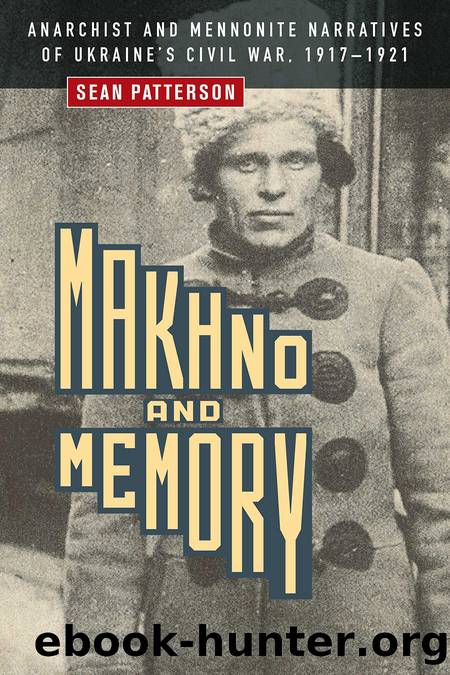Makhno and Memory by Sean Patterson

Author:Sean Patterson
Language: eng
Format: epub
Publisher: University of Manitoba Press
Published: 2020-03-23T22:20:18+00:00
Figure 17. Abram and Maria Janzen.
Figure 18. Worker with horse in front of the Silberfeld estate.
The next encounter comes from Anna Goerz, the daughter of the Ebenfeld estateâs owner Jakob Neufeld. In the 1860s or â70s, Ebenfeld was purchased by Heinrich Kaethler, possibly from the same Russian noble that had owned the neighbouring estate of Silberfeld. Jakob Neufeld came to the estate as a teacher and soon fell in love with Kaethlerâs daughter Maria. The couple married and the estate was later transferred to Neufeld. Makhno had also worked for Neufeld as a youth and they apparently had a positive relationship. Early in the Revolution, prior to the German occupation, Makhno stayed overnight at Ebenfeld. Anna Goerz recalled that âsince their relationship had been good, Makhno showed no hostility . . . he made every effort to establish a friendly basis and when he was offered a key for his room for greater safety, Makhno refused to take it, saying that he felt safe among friends.â132 Goerz describes how Makhno proceeded to the Klassen estate the next morning, where a redistribution was conducted. Here, Klassen was invited to take an equal portion of the goods.133 While it must have struck Klassen as supremely unjust to be apportioned a share of his own property, the account supports Makhnoâs claim that he initially adopted a strategy of integrating former landowners into the movementâs social experiments.
An interaction recorded by Gerhard Schroeder between himself and Schönfeldâs school board president further corroborates Makhnoâs fondness for Neufeld:
But you know, Makhno has promised [Neufeld] not to touch his property or him personally. The question is whether anyone can trust the words of a man like this one. When the period of anarchy broke out, [Neufeld] tried to resist the plundering raids with the help of several German soldiers, and succeeded for awhile in repelling the bandits. However, one day Makhno sent a messenger to this Mennonite landowner. The message read, â[Neufeld], I have not forgotten how in 1906 I found a place of refuge on your estate. There I succeeded in eluding the cruel dogs of the Tsarist police. It was only through your help and cooperation that in 1906 I succeeded in eluding the police and thus was saved from being shot by them. I have not forgotten the old practice of khleb-solâ [hospitality]. . . . Do not shoot anymore, and we promise not to touch either you or your property.â134
Combined with Goerzâs account, it appears Makhno left Neufeldâs estate intact, while moving on to redistribute the neighbouring Klassen estate. The school president is distrustful of Makhno, but the story communicates how personal relationship shaped Makhnoâs treatment of landowners.
Schroeder also provides an account of Makhnoâs first appearance near Schönfeld. Rumours of Makhnoâs approach led the colonyâs men to arm themselves and prepare for a battle. However, âas luck would have it, Makhno did not advance to our village, but sent word the next day that he would leave us unharmed if we surrendered all our weapons at a specified place.
Download
This site does not store any files on its server. We only index and link to content provided by other sites. Please contact the content providers to delete copyright contents if any and email us, we'll remove relevant links or contents immediately.
| Catholicism | Christian Science |
| Jehovah's Witness | Mennonite |
| Messianic Judaism | Mormonism |
| Orthodoxy | Protestantism |
Fangirl by Rainbow Rowell(9104)
How to Bang a Billionaire by Alexis Hall(8075)
Wonder by R. J. Palacio(8014)
The Space Between by Michelle L. Teichman(6864)
The Thirst by Nesbo Jo(6832)
Assassin’s Fate by Robin Hobb(6134)
Wiseguy by Nicholas Pileggi(5674)
The Night Circus by Erin Morgenstern(5157)
Paper Towns by Green John(5092)
The Kite Runner by Khaled Hosseini(5086)
Bittersweet (True North #1) by Sarina Bowen(4806)
Gerald's Game by Stephen King(4584)
Too Much and Not the Mood by Durga Chew-Bose(4278)
Pillow Thoughts by Courtney Peppernell(4214)
Goodbye Paradise(3729)
Twelve Days of Christmas by Debbie Macomber(3519)
Good by S. Walden(3489)
The Rosie Effect by Graeme Simsion(3375)
The Cellar by Natasha Preston(3264)
